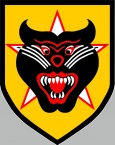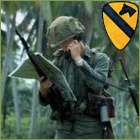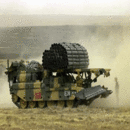comte
Posts: 2358
Joined: 2/4/2009
From: Be'eri, Hadarom, Israel
Status: offline

|
As 1965 began the Viet Cong had entered a new phase of their insurgency against the South Vietnamese
government. The Communists departed from their usual hit and run guerrilla tactics and engaged the armed forces of the Republic of Vietnam (RVNAF) near the village of Binh Gia, 40 miles east of Saigon, in a pitched battle which lasted from 28 December 1964 until 1 January 1965.
During the struggle for Binh Gia, two regiments from the 9th VC Division ambushed and virtually destroyed two battalions of South Vietnamese troops, including the 4th Battalion, Vietnamese Marine Corps, and inflicted heavy casualties on relieving armored and mechanized forces.
According to General Westmoreland, Commander, US Military Assistance Command, Vietnam, Binh Gia marked
the start of the final Communist offensive, "it meant the beginning of an intensive military challenge which the Vietnamese government could not meet with its own
resources".
On 7 February 1965, the Viet Cong attacked the US compound at Pleiku in the Central Highlands, a
provocation that altered the entire course of the war. In the early morning of the 7th, the Viet Cong attacking force laid down a mortar barrage on the advisors'quarters and airfield, killing 9 Americans, wounding 128 others, and damaging or destroying 18 aircraft. At the urging of the Joint Chiefs of Staff and with the concurrence of Ambassador Taylor, President Lyndon B. Johnson ordered retaliatory air strikes against North Vietnam. Addressing the nation later that day, the President announced the
withdrawal of U.S. dependents from Vietnam and warned that the United States might take further actions. He declared: "I have ordered the deployment to South Vietnam of a HAWK air defense battalion. Other
reinforcements, in units and individuals, may follow". Although chances of air retaliation by the small North Vietnamese Air Force were slim, the U.S. Government considered that the deployment of the HAWK missiles in conjunction with the air strike, code named FLAMING DART, on 7 February, would convince Hanoi of American determination to support South Vietnam. The Communists, nevertheless, continued attacks against U.S. installations. On 10 February, the Viet Cong destroyed a U.S. enlisted billet in the coastal city of Qui Nhon, killing 23 U.S. soldiers and wounding 22 others. Once more, President
Johnson, on the recommendation of the Joint Chiefs, ordered U.S. aircraft to bomb the north in retaliation. On 11 February, more than 100 Navy carrier planes struck at military targets in North Vietnam. Following the Qui Nhon attack, on 11 February the Joints Chiefs of Staff forwarded to the Secretary of Defense a program of reprisal actions to be taken against Communist provocations. The chiefs observed that the retaliatory air raids against North Vietnam had not achieved the
intended effect. They recommended in its place a "sustained pressure" campaign to include continuing air
strikes against selected targets in North Vietnam, naval bombardment, covert operations, intelligence patrols and cross-border operations in Laos, and the landing of American troops in South Vietnam. On 13 February, President Johnson approved a "limited and measured" air campaign against North Vietnam, which took the code name ROLLING THUNDER. The ROLLING THUNDER campaign was delayed until 2 March because of a
combination of bad weather and the instability of the South Vietnamese political situation. Confronted with both a deteriorating political and military situation, General Westmoreland directed his deputy,
Lieutenant General John L. Throckmorton, to determine what American ground forces were needed for base
security. After completing his survey, Throckmorton recommended the deployment of a three-battalion Marine expeditionary brigade to Da Nang because of the vital importance of the base for any air campaign against the north and "the questionable capability of the Vietnamese to protect the base". On 22 February, General Westmoreland forwarded this request to Admiral Sharp who in turn informed the JCS
that he agreed with Westmoreland's assessment of the situation. Although expressing strong reservations about sending any American ground forces to Vietnam, Ambassador Taylor, in a message to the State Department on 22 February, agreed to placing one Marine BLT at Da Nang "in view of General Westmoreland's understandable concern for the safety of this important base".
(Taken from U.S. Marines in Vietnam. The Landing and the
Buildup, 1965 by Jack Shulimson and Maj Charles M.
Johnson, Washington, DC: History and Museums Division,
Headquarters U.S.M.C., 1978)
< Message edited by Aces8 -- 8/16/2010 10:01:28 AM >
_____________________________
But when Territories are acquired in regions where there are differences in language, customs, and laws then great good fortune and much hard work are required to hold them.
-Machiavelli, Il Principe, Book III-
|
 Printable Version
Printable Version











 Are you using 3.4 or the older version?
Are you using 3.4 or the older version?























 New Messages
New Messages No New Messages
No New Messages Hot Topic w/ New Messages
Hot Topic w/ New Messages Hot Topic w/o New Messages
Hot Topic w/o New Messages Locked w/ New Messages
Locked w/ New Messages Locked w/o New Messages
Locked w/o New Messages Post New Thread
Post New Thread